Towards Harmonized Reduction of Seismic Vulnerability: Analyzing Regulatory and Incentive Frameworks in the Adriatic—Ionian Region
Abstract
1. Introduction
2. Methodology
2.1. Topics
2.2. Parameters
- (a)
- Year of Issuance refers to the year when the inserted document was initially accepted. It is important to note that the year reflects the first adoption of the document, rather than any subsequent amendments or revisions, including the year of its implementation. For this reason, the provided years are considered more informational and are not used in later comparisons, as in some cases, an older document may have been updated, while in other instances it was entirely re-adopted.
- (b)
- Reference to the EU Regulatory Framework: indicates whether the norm or incentive is linked to existing European legislation that requires or encourages its implementation.
- (c)
- Level at which the Document is in Force: specifies the administrative level at which the document is in force—national, regional, or municipal.
- (d)
- Mandatory Status: clarifies whether the application of the document is obligatory or optional.
- (e)
- Target Groups: for each identified regulatory and incentive instrument, one or more relevant target groups have been assigned, based on the intended users or beneficiaries: public authority (government ministries, local government authorities, regulatory bodies…), professional field (enterprise, SME, interest groups, and practitioners), general public, and education/training.
- (f)
- Referential Period: the timeframe during which the norm or incentive is applicable, either pre- or post-earthquake period.
- (g)
- Reference to Cultural Heritage: indicates whether the document clearly mentions cultural heritage or refers to it in any of its sections.
- (h)
- Public Availability: indicates whether a particular document, norm, regulation, or incentive is accessible to the general public.
- (i)
- For topics seismic norms and seismic incentive frameworks, subtopics to facilitate better classification have been defined.
- Design of new structures: This area covers documents for designing structures that are resistant to seismic forces, ensuring their safety and stability during an earthquake.
- Assessment of existing structures: This involves the evaluation of the seismic performance of existing structures identifying potential vulnerabilities and assessing their ability to withstand seismic events.
- Retrofitting structures: This area focuses on documents for strengthening or upgrading existing structuresto improve their seismic resistance and reduce the risk of damage during an earthquake.
- Direct incentive: This subtopic includes various incentives designed to encourage property owners, builders, and developers to incorporate seismic-resistant features into built environment. It is further divided into: financial (direct financial support, such as grants, subsidies, or tax benefits, to reduce the cost of implementing seismic improvements), economic (incentives such as reduced insurance premiums or other cost-saving measures that promote seismic risk reduction), and volumetric (incentives related to increasing the allowable volume or floor space of buildings if seismic-resistant features are incorporated into their design).
- Raising awareness: This subtopic focuses on initiatives aimed at increasing public and stakeholder awareness about the importance of seismic risk reduction and the available incentives to support seismic resilience in built environment.
2.3. Collection Procedure
- Forms for entering existing documents, which present a substantial part of the survey. A separate form was filled out for each new document. Each form included the determination of the topic and the determination of all the parameters presented in Section 2.2, as well as a short and concise description of the content of the document.
- A concise overview regarding the existing regulatory and incentive measures in the country for each of the topics, being useful for the upcoming comparative activities.
- Essential information on the partner country, with emphasis on its seismic context. Data regarding the country’s size, population, administrative divisions, and significant past earthquakes have been gathered. This was crucial for the continuation of the activities, as the information mentioned helped to highlight key distinctions and commonalities within the regulatory and incentive frameworks of the various partner countries.
- Defining the scope—determining the main topics for the collection of relevant documents;
- selection of key parameters for document description and comparison;
- survey preparation;
- preparation of detailed survey instructions;
- presentation and distribution of the survey and its instructions;
- collection of appropriate documents and completion of surveys by each country;
- review of survey contents and preparation of corrections and additions (in order to achieve consistency);
- preparation of corrections and additions by each country;
- preparation of the final database of the collected regulatory and incentive frameworks, which provides the knowledge base for further improvements (e.g., identification of good practices, etc.).
3. Results and Discussion
3.1. Background
3.2. Seismic Norms
3.3. Building Regulation
3.4. Urban Planning Regulations
3.5. Seismic Incentive Frameworks
3.6. Post-Earthquake Planning
4. Conclusions
Author Contributions
Funding
Data Availability Statement
Acknowledgments
Conflicts of Interest
Abbreviations
| ADRION | Adriatic–Ionian (Region) |
| SN | Seismic Norms |
| BR | Building Regulation |
| UPR | Urban Planning Regulation |
| SIF | Seismic Incentive Frameworks |
| PEP | Post-Earthquake Planning |
References
- Zhang, Y.; Fung, J.F.; Johnson, K.J.; Sattar, S. Review of Seismic Risk Mitigation Policies in Earthquake-Prone Countries: Lessons for Earthquake Resilience in the United States. J. Earthq. Eng. 2022, 26, 6208–6235. [Google Scholar] [CrossRef] [PubMed]
- Uitto, J.I.; Shaw, R. Sustainable Development and Disaster Risk Reduction: Introduction. In Sustainable Development and Disaster Risk Reduction; Uitto, J., Shaw, R., Eds.; Disaster Risk Reduction (Methods, Approaches and Practices); Springer: Tokyo, Japan, 2016. [Google Scholar] [CrossRef]
- Sutanta, H.; Bishop, I.D.B.; Rajabifard, A.R. Integrating Spatial Planning and Disaster Risk Reduction at the Local Level in the Context of Spatially Enabled Government. In Spatially Enabling Society Research, Emerging Trends and Critical Assessment; Rajabifard, A., Crompvoets, J., Kalantari, M., Kok, B., Eds.; Leuven University Press: Leuven, Belgium, 2010; pp. 55–68. [Google Scholar]
- European Civil Protection and Humanitarian Aid Operations. EU Civil Protection Mechanism. Available online: https://ec.europa.eu/echo/what/civil-protection/mechanism_en (accessed on 10 April 2025).
- European Civil Protection and Humanitarian Aid Operations. Disaster Preparedness. Available online: https://ec.europa.eu/echo/what/humanitarian-aid/disaster_preparedness_en (accessed on 10 April 2025).
- United Nations Office for Disaster Risk Reduction. Sendai Framework for Disaster Risk Reduction 2015–2030. 2015. Available online: https://www.undrr.org/publication/sendai-framework-disaster-risk-reduction-2015-2030 (accessed on 4 August 2025).
- European Commission. EU Strategy for the Adriatic and Ionian Region (EUSAIR). 2014. Available online: https://ec.europa.eu/regional_policy/policy/cooperation/macro-regional-strategies/adriatic-ionian_en (accessed on 4 August 2025).
- ADRISEISMIC Project. Deliverable T1.1.1: Report on Collected Norms and Incentives. 2021. Available online: https://adriseismic.adrioninterreg.eu/wp-content/uploads/2021/11/DT.1.1.1_Report-on-collected-norms-and-incentives_final-with-annexes.pdf (accessed on 12 March 2025).
- ADRISEISMIC Project. Deliverable T1.1.2: Comparison Matrix. 2021. Available online: https://adriseismic.adrioninterreg.eu/wp-content/uploads/2021/11/DT.1.1.2_Comparison-matrix_final.pdf (accessed on 12 March 2025).
- Marzani, G.; Cavalieri, B.; Santangelo, A.; Triller, P.; Kreslin, M.; Fassoulas, C.; Tondelli, S. Reducing Seismic Vulnerability of Historic Areas: Moving from Good Practices to Tailored Roadmaps. Sustainability 2025, 17, 5062. [Google Scholar] [CrossRef]
- Conticelli, E.; Proli, S.; Tondelli, S. Integrating Energy Efficiency and Urban Densification Policies: Two Italian Case Studies. Energy Build. 2017, 155, 308–323. [Google Scholar] [CrossRef]
- Artese, S.; De Ruggiero, M.; Salvo, F.; Zinno, R. Economic Convenience Judgments among Seismic Risk Mitigation Measures and Regulatory and Fiscal Provisions: The Italian Case. Sustainability 2021, 13, 3269. [Google Scholar] [CrossRef]
- Central Intelligence Agency. The World Factbook. Available online: https://www.cia.gov/the-world-factbook/ (accessed on 7 April 2025).
- Eurostat. Population on 1 January by Age and Sex. 2025. Available online: https://ec.europa.eu/eurostat/databrowser/view/demo_pjan/default/table?lang=en (accessed on 7 April 2025).
- Eurostat. GDP and Main Components (Output, Expenditure and Income)—Per Capita. 2025. Available online: https://ec.europa.eu/eurostat/databrowser/view/NAMA_10_PC/default/table?lang=en (accessed on 7 April 2025).
- Fundo, A.; Duni, L.; Kuka, S.; Begu, E.; Kuka, N. Probabilistic seismic hazard assessment of Albania. Acta Geod. Geophys. Hung. 2012, 47, 465–479. [Google Scholar] [CrossRef]
- Herak, M. Eurocodes Third Balkan Workshop. Eurocodes 2022. Available online: https://eurocodes.jrc.ec.europa.eu/sites/default/files/2022-06/1530_Eurocodes_Third_Balkan_WS_MHerak.pdf (accessed on 4 April 2025).
- Crowley, H.; Silva, V.; Martins, L. Seismic design code calibration based on individual and societal risk. In Proceedings of the 16th European Conference on Earthquake Engineering, Thessaloniki, Greece, 18–21 June 2018; Available online: https://www.researchgate.net/publication/327270542_Seismic_Design_Code_Calibration_Based_on_Individual_and_Societal_Risk (accessed on 4 April 2025).
- INGV. Instituto Nazionale di Geofisica e Vulcanologia—Zone Sismiche, 2004. Available online: http://zonesismiche.mi.ingv.it/ (accessed on 4 April 2025).
- SSS. Seismic Hazard Maps for Serbia. Seismological Survey of Serbia, 2018. Available online: https://www.seismo.gov.rs/Seizmicnost/Karte_hazarda_e.htm (accessed on 4 April 2025).
- ARSO. Seismic Hazard Map 2021. Available online: https://potresi.arso.gov.si/doc/dokumenti/potresna_nevarnost/Karta_potresne_nevarnosti_2021.jpg (accessed on 4 April 2025).
- List of Earthquakes in Albania. Available online: https://en.wikipedia.org/wiki/List_of_earthquakes_in_Albania (accessed on 4 April 2025).
- List of Earthquakes in Croatia. Available online: https://en.wikipedia.org/wiki/List_of_earthquakes_in_Croatia (accessed on 4 April 2025).
- List of Earthquakes in Greece. Available online: https://en.wikipedia.org/wiki/List_of_earthquakes_in_Greece (accessed on 4 April 2025).
- List of Earthquakes in Italy. Available online: https://en.wikipedia.org/wiki/List_of_earthquakes_in_Italy (accessed on 4 April 2025).
- Blagojević, N.; Brzev, S.; Petrović, M.; Borozan, J.; Bulajić, B.; Marinković, M.; Hadzima-Nyarko, M.; Koković, V.; Stojadinović, B. Residential building stock in Serbia: Classification and vulnerability for seismic risk studies. Bull. Earthq. Eng. 2023, 21, 1–69. [Google Scholar] [CrossRef]
- ARSO. Močni Potresi v Preteklosti. Environmental Agency of the Republic of Slovenia. Available online: https://potresi.arso.gov.si/doc/dokumenti/potresna_aktivnost/mocni_potresi_v_preteklosti.pdf (accessed on 4 April 2025).
- European Federation of Earthquake Engineering. Earthquake Hazard Map. Available online: http://www.efehr.org/earthquake-hazard/hazard-map/ (accessed on 25 March 2025).
- EN 1998-1:2004; Eurocode 8: Design of Structures for Earthquake Resistance. European Committee for Standardization: Brussels, Belgium, 2004.
- Albanian Institute of Construction. Earthquake Resistant Design Regulations, KTP-N.2-89; Seismic Center, Academy of Science of Albania; Department of Design, Ministry of Construction: Tirana, Albania, 1989. [Google Scholar]
- Galić, J.; Vukić, H.; Andrić, D.; Stepinac, L. Manual for Earthquake Restoration of Existing Masonry Buildings, 2020; University of Zagreb, Faculty of Architecture: Zagreb, Croatia, 2020; Available online: https://www.arhitekt.hr/files/radovi/privitak/347/ZA%20DIGITALNU%20OBJAVU%20_%2020200707%20_%20PRIRU%C4%8CNIK0.pdf (accessed on 14 February 2025).
- Galić, J.; Vukić, H.; Andrić, D.; Stepinac, L. Manual—Techniques for the Repair and Strengthening of Masonry Buildings, 2020; University of Zagreb, Faculty of Architecture: Zagreb, Croatia, 2020; Available online: https://www.arhitekt.hr/files/radovi/privitak/348/ZA%20DIGITALNU%20OBJAVU%20_%2020200706%20_%20TEHNIKE0.pdf (accessed on 14 February 2025).
- Ministry of Environment, Physical Planning and Public Works. Greek Seismic Code (EAK 2000), 2000; Organization for Seismic Protection (OASP): Athens, Greece, 2000; Available online: https://oasp.gr/userfiles/EAK2000.pdf (accessed on 24 March 2025).
- Earthquake Planning and Protection Organization of Greece (EPPO). KAN.EPE—Code of Structural Interventions, 2017; Earthquake Planning and Protection Organization of Greece: Athens, Greece, 2017; Available online: https://ecpfe.oasp.gr/sites/default/files/files/full.pdf (accessed on 12 February 2025).
- Organization for the Seismic Planning and Protection (OASP). Guidelines for Assessment and Structural Interventions on Masonry Buildings, 2021; OASP: Athens, Greece, 2021; Available online: https://oasp.gr/sites/default/files/KADET_%CE%91%CE%B3%CE%B3%CE%BB%CE%B9%CE%BA%CE%AE%20%CE%AD%CE%BA%CE%B4%CE%BF%CF%83%CE%B7.pdf (accessed on 14 February 2025).
- Ministry of Infrastructure and Transport. NTC 2018—Technical Frameworks for Construction, Official Gazette of the Italian Republic, No. 73, 27 March 2018; Ministry of Infrastructure and Transport: Rome, Italy, 2018; Available online: https://www.gazzettaufficiale.it/eli/gu/2018/02/20/42/so/8/sg/pdf (accessed on 12 February 2025).
- Ministry of Infrastructure and Transport. Explanatory Circular for NTC 2018, Official Gazette of the Republic of Italy, No. 35, Supplement No. 5, 11 February 2019; Ministry of Infrastructure and Transport: Rome, Italy, 2019; Available online: https://www.gazzettaufficiale.it/eli/gu/2019/02/11/35/so/5/sg/pdf (accessed on 12 February 2025).
- Presidency of the Council of Ministers. DPCM 9/02/2011—Evaluation and Reduction of Seismic Risk of Cultural Heritage in Accordance with NTC 2008, Official Gazette of the Republic of Italy, No. 47, Supplement No. 54, 26 February 2011; Presidency of the Council of Ministers: Rome, Italy, 2011; Available online: https://www.gazzettaufficiale.it/eli/gu/2011/02/26/47/so/54/sg/pdf (accessed on 12 February 2025).
- Regional Government of Emilia-Romagna. Regional Law No. 19/2008—Norms for the Reduction of Seismic Risk, Official Gazette of the Region of Emilia-Romagna, No. 19, 2008; Regional Government of Emilia-Romagna: Bologna, Italy, 2008; Available online: https://demetra.regione.emilia-romagna.it/al/articolo?urn=er:assemblealegislativa:legge:2008;19&dl_t=text/xml&dl_a=y&dl_id=10&pr=idx,0;artic,1;articparziale,0&ev=1 (accessed on 12 February 2025).
- Emilia-Romagna Regional Government. D.G.R. n. 2272/2016—List of Interventions Without Relevance for Public Safety and Non-Substantial Variants, Official Gazette of the Emilia-Romagna Region, No. 2272, 2016; Emilia-Romagna Regional Government: Bologna, Italy, 2016; Available online: https://bur.regione.emilia-romagna.it/dettaglio-inserzione?i=d1ac761a60af49bdb4b2f76c8aa9560c (accessed on 12 February 2025).
- Emilia-Romagna Regional Government. Regional Law No. 16/2012—Norms for the Reconstruction in Areas Affected by the Earthquake of May 20 and 29, 2012, Official Gazette of the Emilia-Romagna Region, No. 16, 21 December 2012; Emilia-Romagna Regional Government: Bologna, Italy, 2012; Available online: https://www.gazzettaufficiale.it/eli/gu/2013/01/26/4/s3/pdf (accessed on 12 February 2025).
- Italian Government. Legislative Decree No. 189/2016—Provisions for the Declaration of a State of Emergency and Management of Interventions Following Natural Disasters, Official Gazette of the Italian Republic, No. 194, 24 August 2016; Italian Government: Rome, Italy, 2016; Available online: https://www.gazzettaufficiale.it/eli/gu/2016/12/17/294/sg/pdf (accessed on 12 February 2025).
- Italian Government. OPCM n. 3519/2006—Update of the Seismic Classification of the Italian Territory, Official Gazette of the Italian Republic, No. 108, 11 May 2006; Italian Government: Rome, Italy, 2006; Available online: https://www.gazzettaufficiale.it/eli/id/2006/05/11/06A04427/sg (accessed on 12 February 2025).
- Emilia-Romagna Regional Government. DGR n. 1164/2018—Update of the Seismic Classification of Municipalities in Emilia-Romagna, Official Gazette of the Emilia-Romagna Region, No. 263, 8 August 2018; Emilia-Romagna Regional Government: Bologna, Italy, 2018; Available online: https://bur.regione.emilia-romagna.it/dettaglio-inserzione?i=4aa04946b4fc4dcd8cc4ef742dea83ad (accessed on 12 February 2025).
- Council of Ministers, Albania. Decision No. 159, Dated March 1, 2017, Approving the Design Standards for Kindergartens, 2017; Council of Ministers: Tirana, Albania, 2017. [Google Scholar]
- Council of Ministers, Albania. Decision No. 319, Dated April 12, 2017, Approving the Design Standards for Schools, 2017; Council of Ministers: Tirana, Albania, 2017. [Google Scholar]
- Republic of Croatia. Building Act (Official Gazette No. 153/13), Amended by the Act on the State Inspectorate (Official Gazette No. 115/18 and 117/21), 2013. Available online: https://narodne-novine.nn.hr/clanci/sluzbeni/2013_12_153_3221.html (accessed on 13 March 2025).
- Greece. New Building Regulation—Law 4067/2012, Official Gazette of the Hellenic Republic: Athens, Greece, 2012; No. 79/A, 9 April 2012. Available online: https://www.elinyae.gr/ethniki-nomothesia/n-40672012-fek-79a-942012 (accessed on 19 March 2025).
- Greece. Decision No. 3328—Reinforced Concrete Regulation, Official Government Gazette ΦΕΚ 1561Β/2-6-2016. Available online: https://www.e-nomothesia.gr/inner.php/kat-periballon/oikodomes/upourgike-apophase-gdtu-oik-3328-2016.html?print=1 (accessed on 19 March 2025).
- Greece. YA D1492330/2008—Steel Regulation, Official Government Gazette ΦΕΚ 1416/Β/17-7-2008, Athens, Greece, 2008. Available online: https://www.elinyae.gr/ethniki-nomothesia/ya-d14923302008-fek-1416b-1772008 (accessed on 12 March 2025).
- Comune di Bologna. Building Regulations of the Municipality of Bologna, 2020Italy, 2020. Available online: http://sit.comune.bologna.it/alfresco/d/d/workspace/SpacesStore/4dbbe351-b42b-429f-b052-288455390fa5/RegolamentoEdilizio.pdf (accessed on 12 February 2025).
- Presidency of the Republic of Italy. Republication of the Decree of the President of the Republic No. 380 of June 6, 2001—Consolidated Text of Legislative and Regulatory Provisions in Construction Matters (Text A), with Related Notes, Official Gazette of the Italian Republic, No. 266—Ordinary Supplement No. 246, 15 November 2001. Presidency of the Republic of Italy: Rome, Italy, 2001. Available online: https://www.gazzettaufficiale.it/eli/gu/2001/11/15/266/so/246/sg/pdf (accessed on 12 February 2025).
- Republic of Serbia. Planning and Building Act (Official Gazette No. 72/09, 81/09, 64/10, 24/11, 121/12, 42/13, 50/13, 98/13, 132/14, 145/14, 9/16, 113/17, 32/18), 2009. Available online: https://www.paragraf.rs/propisi/planning-and-building-act-serbia.html (accessed on 13 March 2025).
- Republic of Serbia. Regulation on Building Structures (Official Gazette No. 23/19), 2019. Available online: https://www.paragraf.rs/propisi/pravilnik-za-gradjevinske-konstrukcije.html (accessed on 13 March 2025).
- Republic of Slovenia. Construction Act (Official Gazette No. 61/17, as Amended by Official Gazette No. 199/21), 2017. Available online: https://pisrs.si/pregledPredpisa?id=ZAKO8244 (accessed on 13 March 2025).
- Republic of Albania. Law No. 107/2014 on Territorial Planning and Development, 2014. Available online: http://planifikimi.gov.al/index.php?eID=dumpFile&t=f&f=4762&token=4cc99e01cad52e01a037e7080035a2dc749f03f5 (accessed on 4 March 2025).
- Ministry of Urban Development, Albania. General Local Plan of the Gjirokastër Municipality, 2015. Available online: http://planifikimi.gov.al/index.php?eID=dumpFile&t=f&f=1733&token=360d1727adfc6805ad4100f7525d667f20bb663f (accessed on 4 March 2025).
- Government of Croatia. Physical Planning Act No. 153/2013 (NN 153/13, 65/17, 114/18, 39/19, 98/19, 67/23), 2013. Available online: https://www.zakon.hr/z/689/Zakon-o-prostornom-ure%C4%91enju (accessed on 4 March 2025).
- Ministry of Environment, Energy and Climate Change, Greece. Decision No. 42284/13.10.2017—Revised Regional Spatial Framework, 2017. Available online: https://ypen.gov.gr/wp-content/uploads/2020/11/20200728_Krhth_FEK.pdf (accessed on 4 March 2025).
- Greek Ministry of Environment. General Urban Plans (Law No. 2508/1997), Official Government Gazette, FEK A 124/13.06.1997. Available online: https://www.kodiko.gr/nomothesia/document/207014/nomos-2508-1997 (accessed on 20 March 2025).
- Greek Ministry of Environment, Energy and Climate Change. Ministry Decision No. 37691/2007: Geological Suitability Studies of Rocks for the Implementation of General Town Plans, 2007. Available online: https://www.nomoskopio.gr/a_37691_07.php?toc=0 (accessed on 20 March 2025).
- Regional Government of Emilia-Romagna, Italy. Regional Law No. 24/2017—Regional Regulation on Land Protection and Use, 2017. Available online: https://demetra.regione.emilia-romagna.it/al/articolo?urn=er:assemblealegislativa:legge:2017;24 (accessed on 4 March 2025).
- Ministry of Construction, Transport, and Infrastructure, Republic of Serbia. Rules on the Content, Method, and Procedure for Preparing Spatial and Urban Planning Documents, Official Gazette of the Republic of Serbia, No. 32/2019, 2019. Available online: http://www.pravno-informacioni-sistem.rs/SlGlasnikPortal/eli/rep/sgrs/ministarstva/pravilnik/2019/32/2/reg/ (accessed on 4 March 2025).
- Government of Serbia. Strategy for Sustainable Urban Development of the Republic of Serbia until 2030, Official Gazette of the Republic of Serbia, No. 47/2019, 2019. Available online: https://pravno-informacioni-sistem.rs/eli/rep/sgrs/vlada/strategija/2019/47/1/reg (accessed on 4 March 2025).
- Republic of Slovenia. Spatial Planning Act (ZUreP-3), Official Gazette of the Republic of Slovenia, No. 199/21, 2021. Available online: https://pisrs.si/pregledPredpisa?id=ZAKO8249 (accessed on 4 March 2025).
- Ministry of Environment and Spatial Planning, Slovenia. Regulatory Elements of Spatial Planning Handbook, 2020. Available online: https://www.gov.si/assets/ministrstva/MOP/Dokumenti/Prostorski-red/regulacijski_elementi.pdf (accessed on 4 March 2025).
- Greece. FEK 2943/B-2023: Seismic Inspection of Public Buildings and Critical Infrastructure. Official Gazette, Government of Greece, 2023. Available online: https://oasp.gr/sites/default/files/inline-files/%CE%A6%CE%95%CE%9A_2943-%CE%92-2023.pdf (accessed on 20 March 2025).
- Italian Parliament. Law No. 77/2020—Conversion of Decree-Law No. 34/2020 (Relaunch Decree), Including the Introduction of Superbonus 110% for Energy Efficiency and Seismic Risk Reduction. Official Gazette of the Italian Republic, General Series No. 181, 19 July 2020. Available online: https://www.normattiva.it/atto/caricaDettaglioAtto?atto.dataPubblicazioneGazzetta=2020-07-18&atto.codiceRedazionale=20G00095&atto.articolo.numero=0&atto.articolo.sottoArticolo=1&atto.articolo.sottoArticolo1=0&qId=b06fd8ec-3295-48b4-8cfe-1544a7507821&tabID=0.0234317932249819&title=lbl.dettaglioAtto (accessed on 20 March 2025).
- Ministry of Infrastructure and Transport, Italy. Decree No. 58/2017—Guidelines for the Evaluation of Seismic Vulnerability of Buildings, Official Gazette No. 173, 2017. Available online: https://www.mit.gov.it/sites/default/files/media/normativa/2020-01/Testo%20coordinato%20del%20DM%20n%2058%20del%2028-02-2017.pdf (accessed on 4 March 2025).
- Department of Civil Protection, Italy. “I Don’t Take Risks”—National Awareness Campaign for Risk Prevention and Preparedness, 2010. Available online: https://eventi.protezionecivile.gov.it/en/i-dontt-take-risks/ (accessed on 4 March 2025).
- Emilia-Romagna Region, Italy. Volumetric Incentives for Seismic Retrofitting Interventions, Building Regulations of Bologna Municipality, 2017. Available online: http://sit.comune.bologna.it/alfresco/d/d/workspace/SpacesStore/4dbbe351-b42b-429f-b052-288455390fa5/RegolamentoEdilizio.pdf%20art.30 (accessed on 4 March 2025).
- National Institute of Geophysics and Volcanology & National Department of Civil Protection, Italy. EDURISK—Increasing Knowledge and Awareness of Seismic Risk in Schools, 2011. Available online: http://www.edurisk.it/ (accessed on 4 March 2025).
- Civil Protection Department, EUCENTRE Foundation, & ReLUIS, Italy. “Secure +”—Online Tool to Raise Awareness on Seismic Risk of Italian Municipalities, 2020. Available online: https://www.sicuropiu.it/index.xhtml (accessed on 4 March 2025).
- Administration of the Republic of Slovenia for Civil Protection and Disaster Relief. POTROG Applications. Available online: http://potrog2.vokas.si/ (accessed on 4 March 2025).
- Law No. 45/2019 on Civil Protection, Official Gazette of Albania, 2019. Available online: https://www.qbz.gov.al/eli/fz/2019/113/837b2b34-2833-4add-8635-994462b57cc5;q=45%2F2019 (accessed on 20 March 2025).
- National Civil Emergency Plan, Official Gazette of the Republic of Albania, No. 113, 2023. Available online: https://www.undp.org/albania/publications/national-civil-emergency-plan (accessed on 13 March 2025).
- Emergency Seismic Reconstruction Program, Faculty of Civil Engineering, University of Zagreb, Croatian Chamber of Civil Engineers, 2020. Available online: https://www.hkig.hr/fdsak3jnFsk1Kfa/strucna_izdanja/UPPO-Urgentni_program_potresne_obnove-Prirucnik_HKIG.pdf (accessed on 4 March 2025).
- Plan for the Development of the Civil Protection System in the Area of the City of Kaštela, Official Gazette of the City of Kaštela, No. 12/2016, page 64. Available online: https://kastela.hr/wp-content/uploads/datoteke/dokumenti/sluzbeni-glasnici/2016/sluzbeni-glasnik-broj-12.pdf (accessed on 11 March 2025).
- Plan for Protection and Rescue in the Republic of Croatia, Official Gazette of the Republic of Croatia, No. 96/2010, 2010. Available online: https://narodne-novine.nn.hr/clanci/sluzbeni/full/2010_08_96_2707.html (accessed on 6 March 2025).
- Law on the Civil Protection System, Official Gazette of the Republic of Croatia, Nos. 82/15 and 118/2018, 2015. Available online: https://www.zakon.hr/z/809/Zakon-o-sustavu-civilne-za%C5%A1tite (accessed on 6 March 2025).
- Law on the Reconstruction of Buildings Damaged by the Earthquake in the City of Zagreb, Krapina-Zagorje County, and Zagreb County, Official Gazette of the Republic of Croatia, No. 102/2020, 2020. Available online: https://narodne-novine.nn.hr/clanci/sluzbeni/2020_09_102_1915.html (accessed on 13 March 2025).
- The Manual for Emergency Seismic Reconstruction Program, Faculty of Civil Engineering, University of Zagreb & Croatian Chamber of Civil Engineers, 2020. Available online: http://www.grad.unizg.hr/_download/repository/UPPO_Prirucnik_GF_HKIG.pdf (accessed on 13 March 2025).
- Ministerial Decision No. 1299/2003—General Civil Protection Plan “Xenokrates”, Ministry of the Interior, Greece, 2003. Available online: https://www.e-nomothesia.gr/kat-politike-prostasia-psea-pallaike-amyna/ya-1299-2003.html (accessed on 13 March 2025).
- Law No. 4662/2020—National Policy for Civil Protection and Risk Management, Published in the Government Gazette, Issue 27, 2020. Available online: https://www.e-nomothesia.gr/kat-politike-prostasia-psea-pallaike-amyna/nomos-4662-2020-phek-27a-7-2-2020-1.html (accessed on 13 March 2025).
- Greece. 2nd Edition of the General Civil Protection Plan for Earthquake Emergency Response and Impact Management "ENGELADOS II"; Ministry of Climate Crisis and Civil Protection: Athens, Greece, 2023. Available online: https://civilprotection.gov.gr/sxedia-politikis-prostasias/2i-ekdosi-genikoy-shedioy-antimetopisis-ektakton-anagkon-kai (accessed on 20 March 2025).
- Greece. Law 3013/2002, Greek Government Gazette (ΦΕΚ) 3A, 2002. Available online: https://www.e-nomothesia.gr/kat-politike-prostasia-psea-pallaike-amyna/n-3013-2002.html (accessed on 20 March 2025).
- General Secretariat for Civil Protection. Guidelines for the Planning and Implementation of Civil Protection Exercises; Prot. No. 532/23-01-2020; General Secretariat for Civil Protection: Athens, Greece, 2020. [Google Scholar]
- National Plan for the Prevention of Seismic Risk (Piano Nazionale per la Prevenzione del Rischio Sismico), Law No. 77 of June 24, 2009. Available online: https://www.parlamento.it/parlam/leggi/09077l.htm (accessed on 25 March 2025).
- National Seismic Risk Rescue Program—DPCM 14/01/2014. Official Gazette No. 41, 2014. Available online: https://www.gazzettaufficiale.it/eli/gu/2009/06/27/147/so/99/sg/pdf (accessed on 4 March 2025).
- Annex II of the National Seismic Risk Rescue Program, Emilia-Romagna Regional Government Resolution No. 1669, 2019. Available online: https://servizissiir.regione.emilia-romagna.it/deliberegiunta/servlet/AdapterHTTP?action_name=ACTIONRICERCADELIBERE&operation=leggi&cod_protocollo=GPG/2019/1687&ENTE=1 (accessed on 20 March 2025).
- Municipal Civil Protection Plan of Bologna, Municipality of Bologna, 2016. Available online: http://www.comune.bologna.it/sites/default/files/documenti/2016-04-15%20Piano%20Comunale%20ProtCiv.pdf (accessed on 4 March 2025).
- Seismic Microzonation (MS) Studies under OPCM 3907/2010, Italian Civil Protection Department, 2010. Available online: https://www.protezionecivile.gov.it/it/normativa/opcm-n-3907-del-13-novembre-2010-0/ (accessed on 25 March 2025).
- Analysis of the Emergency Limit Condition (CLE) under OPCM 4007/12, Contributions for Seismic Risk Prevention Interventions for 2011, 2012. Available online: https://www.protezionecivile.gov.it/it/normativa/opcm-n-4007-del-29-febbraio-2012-0/ (accessed on 24 March 2025).
- Law on Recovery Following Natural and Other Disasters, Official Gazette of the Republic of Serbia, No. 102, Belgrade, 2020. Available online: https://www.obnova.gov.rs/uploads/useruploads/Documents/Zakon_o_obnovi%20nakon%20el%20i%20druge%20nepogode_engl.pdf (accessed on 13 March 2025).
- Law on Disaster Risk Reduction and Emergency Management, Official Gazette of the Republic of Serbia, No. 87, Belgrade, 2018. Available online: https://www.paragraf.rs/propisi/zakon-o-smanjenju-rizika-od-katastrofa-i-upravljanju-vanrednim-situacijama.html (accessed on 13 March 2025).
- Catastrophe Risk Assessment in the Republic of Serbia, Ministry of the Interior, 2019. Available online: http://prezentacije.mup.gov.rs/svs/HTML/licence/Procena%20rizika%20od%20katastrofa%20u%20RS.pdf (accessed on 13 March 2025).
- Republic of Slovenia. Law on Protection Against Natural and Other Disasters. Official Gazette of the Republic of Slovenia, No. 64/2006. 2006. Available online: http://pisrs.si/Pis.web/pregledPredpisa?id=ZAKO364 (accessed on 13 March 2025).
- Republic of Slovenia. Resolution on Strengthening Earthquake Resilience by 2050 “BEAT THE EARTHQUAKE” (ReKPV50). Official Gazette of the Republic of Slovenia, No. 3592. 2023. Available online: https://www.uradni-list.si/_pdf/2023/Ur/u2023122.pdf (accessed on 13 March 2025).
- Decree on the Methodology for Damage Assessment. Official Gazette of the Republic of Slovenia, No. 68/2008. Available online: http://www.pisrs.si/Pis.web/pregledPredpisa?id=URED2969 (accessed on 13 March 2025).
- Decree on the Organization, Equipment, and Training of Protection and Aid Forces. Official Gazette of the Republic of Slovenia, No. 87/2016. Available online: https://pisrs.si/pregledPredpisa?id=URED3994 (accessed on 13 March 2025).
- National Earthquake Protection and Rescue Plan, Version 3.2. Updated 2024. Ministry of Defence of the Republic of Slovenia. Official Gazette of the Republic of Slovenia, No. 15/2024. Available online: https://www.gov.si/assets/organi-v-sestavi/URSZR/Datoteke/Drzavni-nacrti/dn_potres_azuriran_2024.pdf (accessed on 13 March 2025).
- Municipal Earthquake Protection and Rescue Plan for the City of Ljubljana. City of Ljubljana, 2024. Available online: https://www.ljubljana.si/assets/Uploads/Nacrt-MOL-za-zascito-in-resevanje-ob-potresu-2024.pdf (accessed on 12 February 2025).
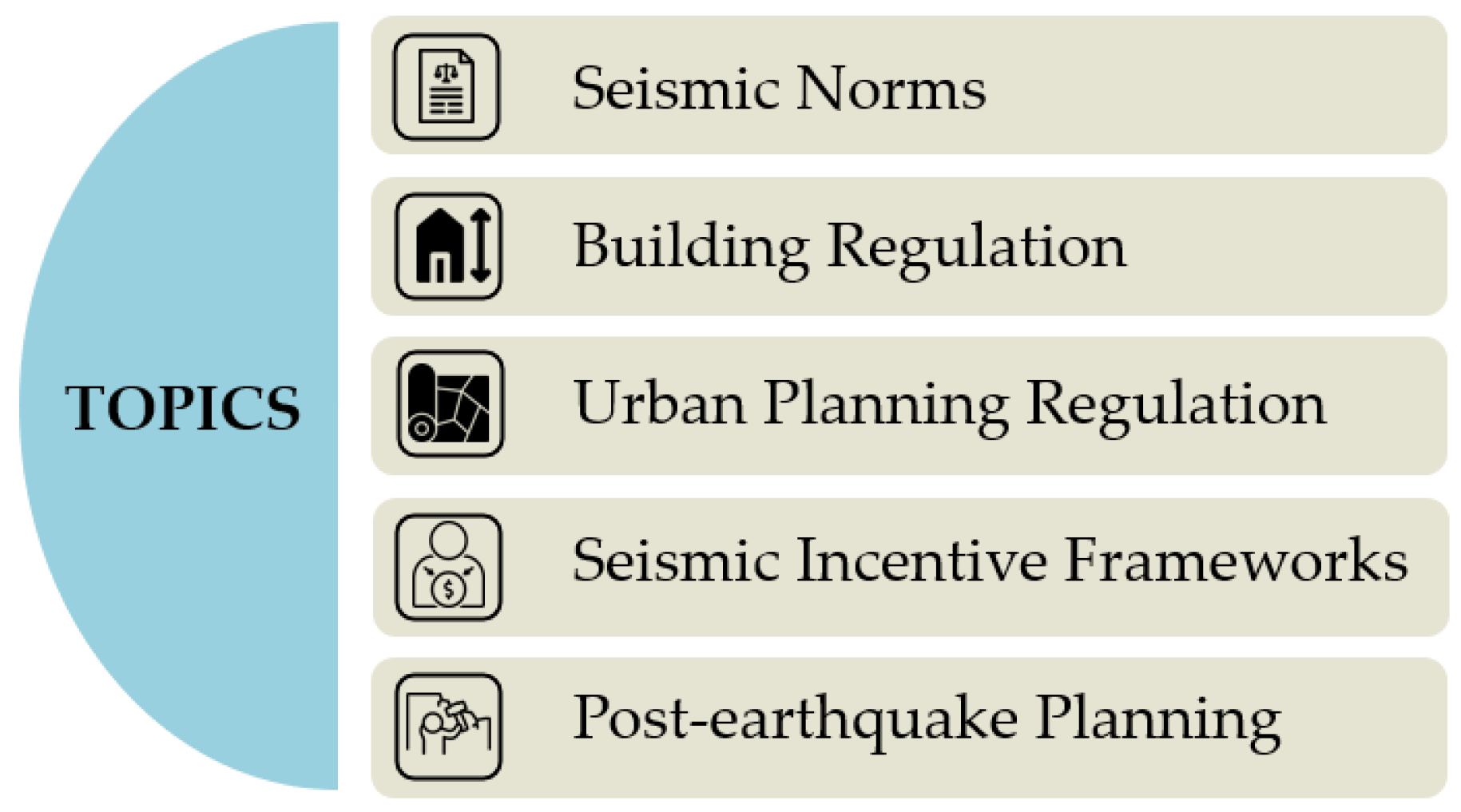
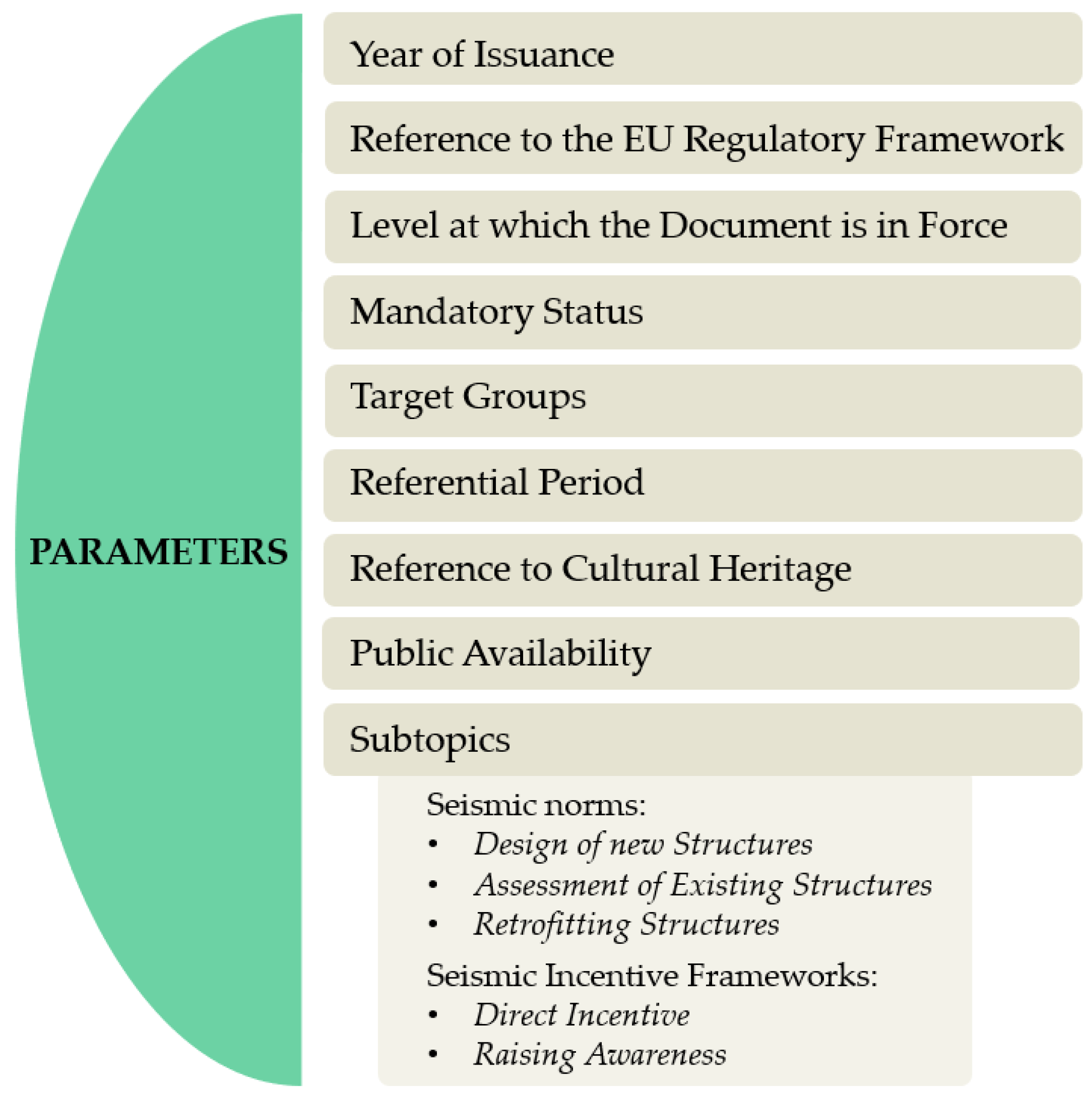

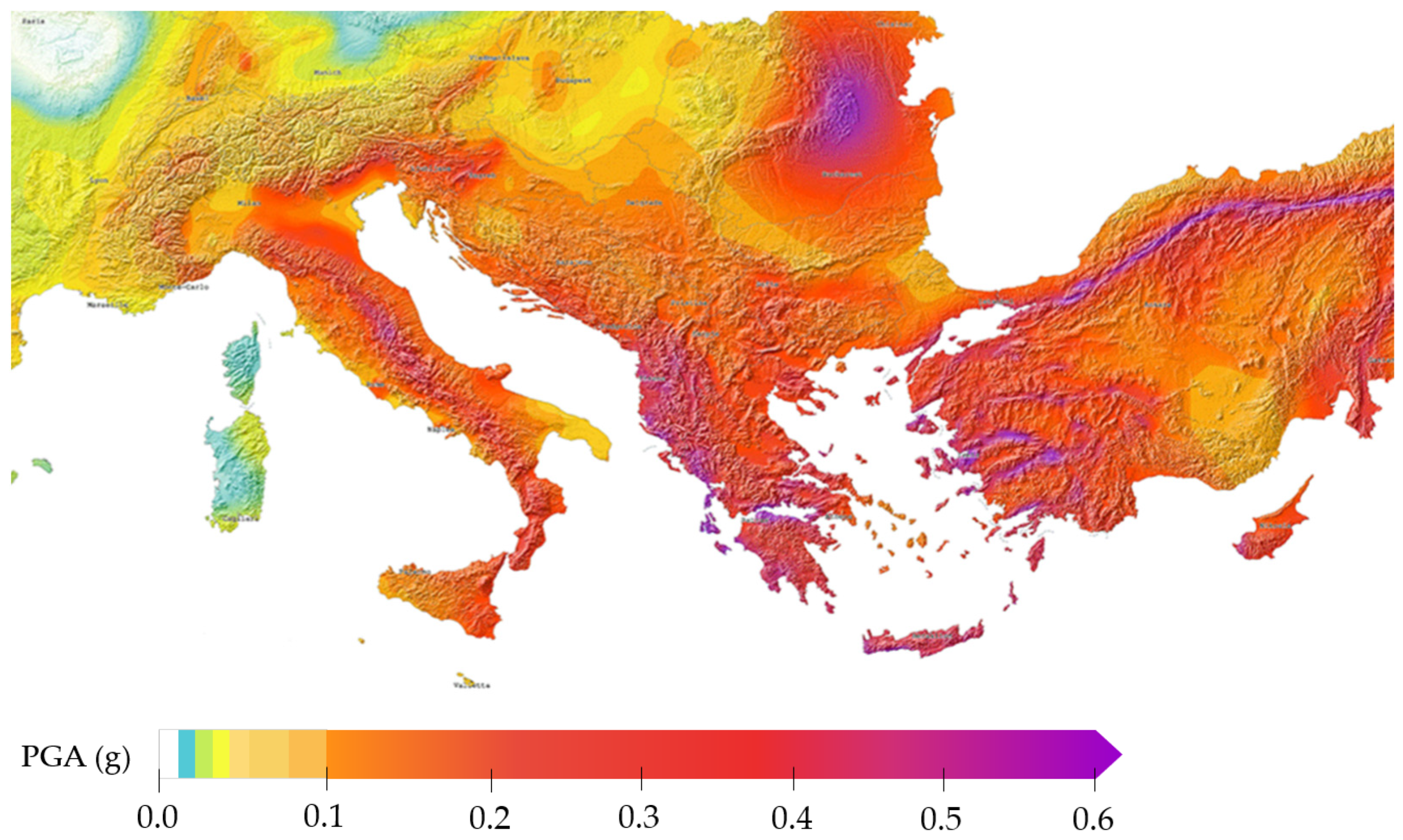
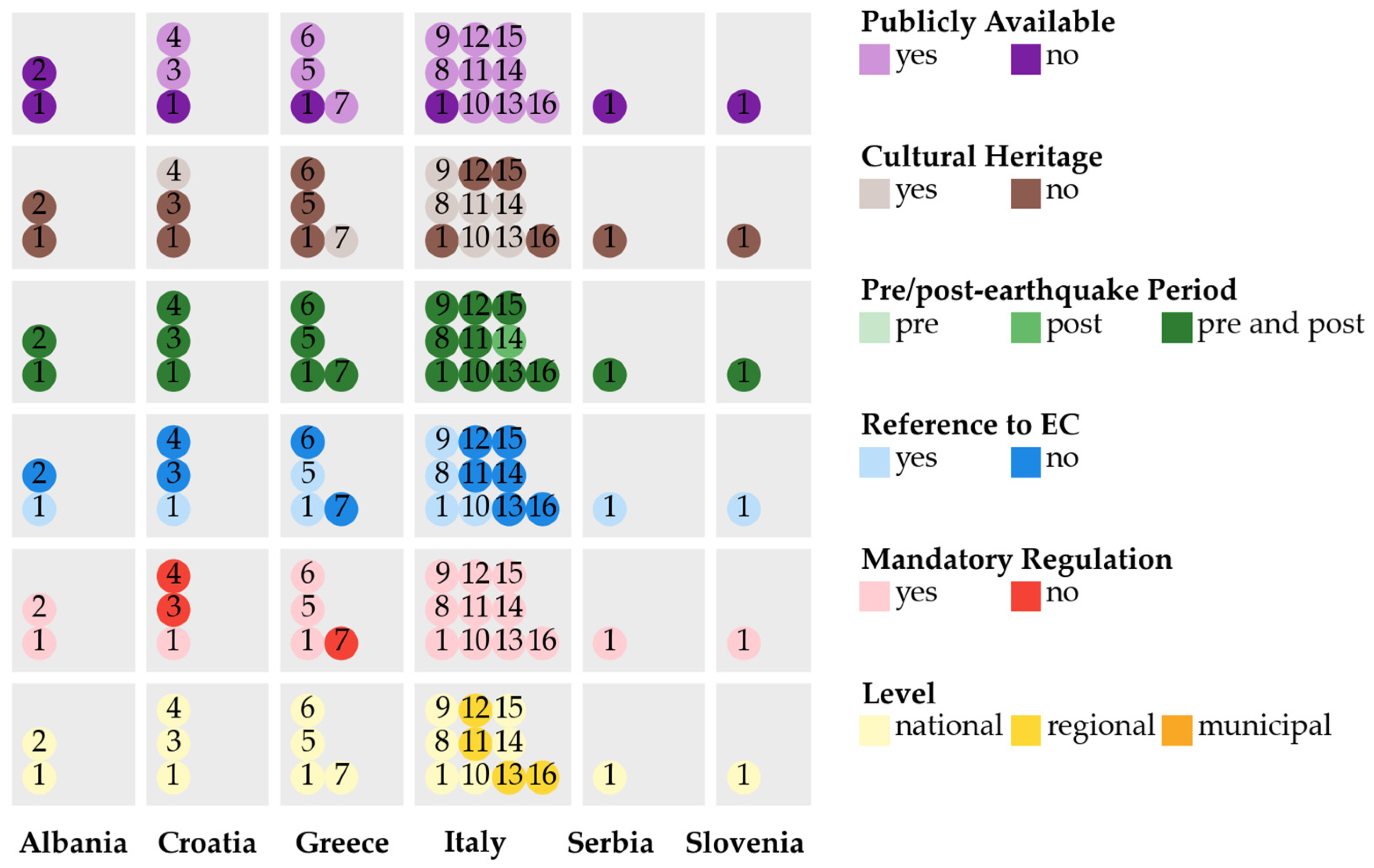


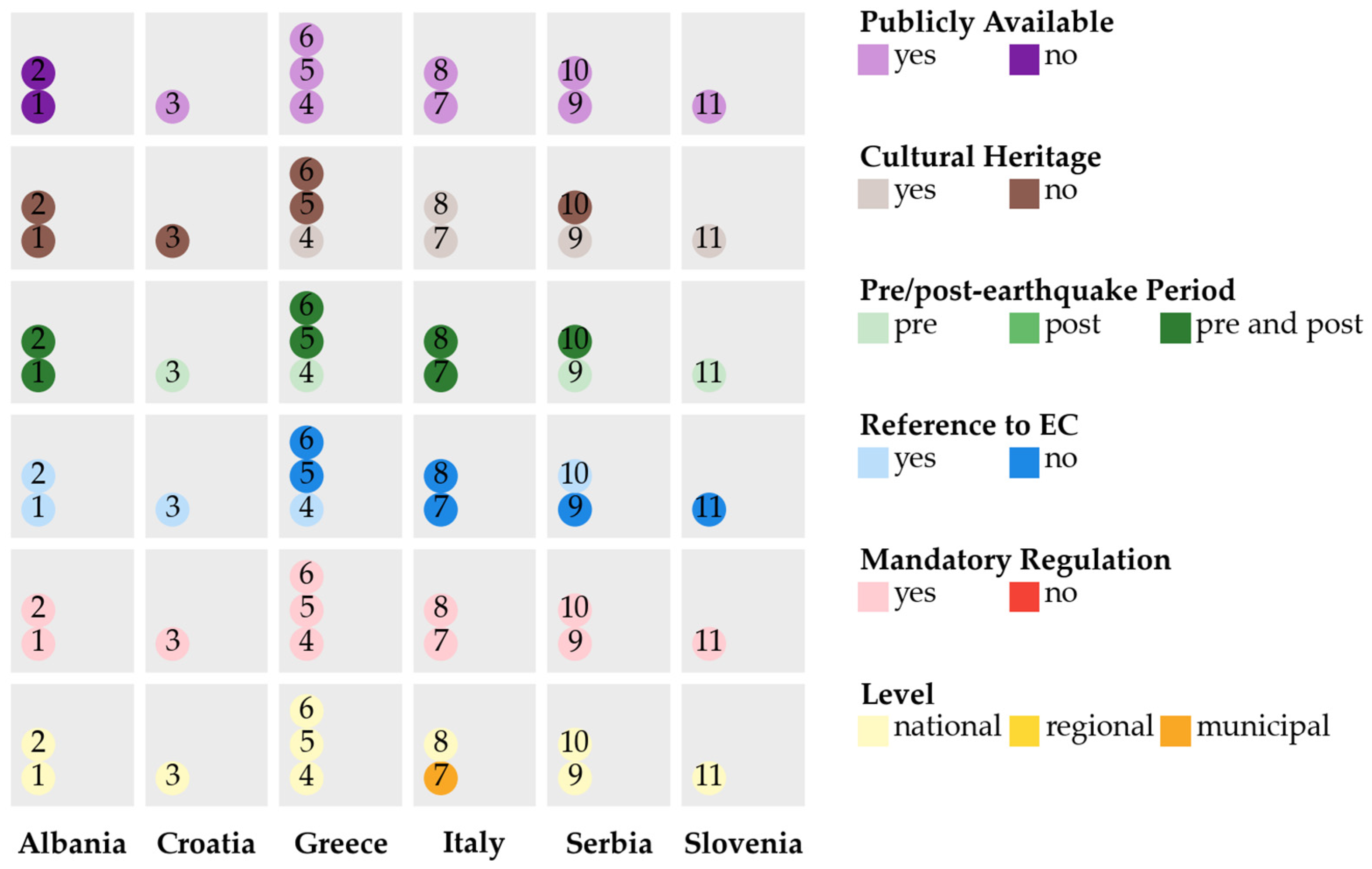
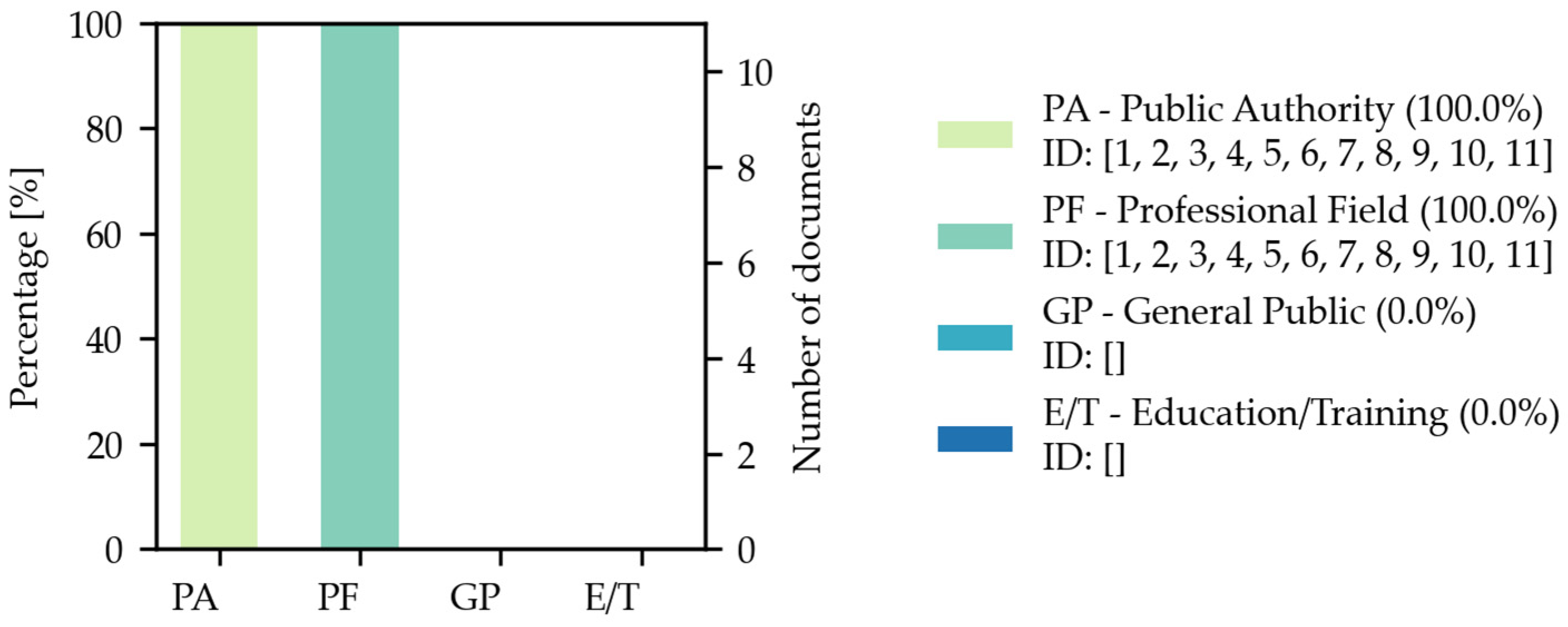
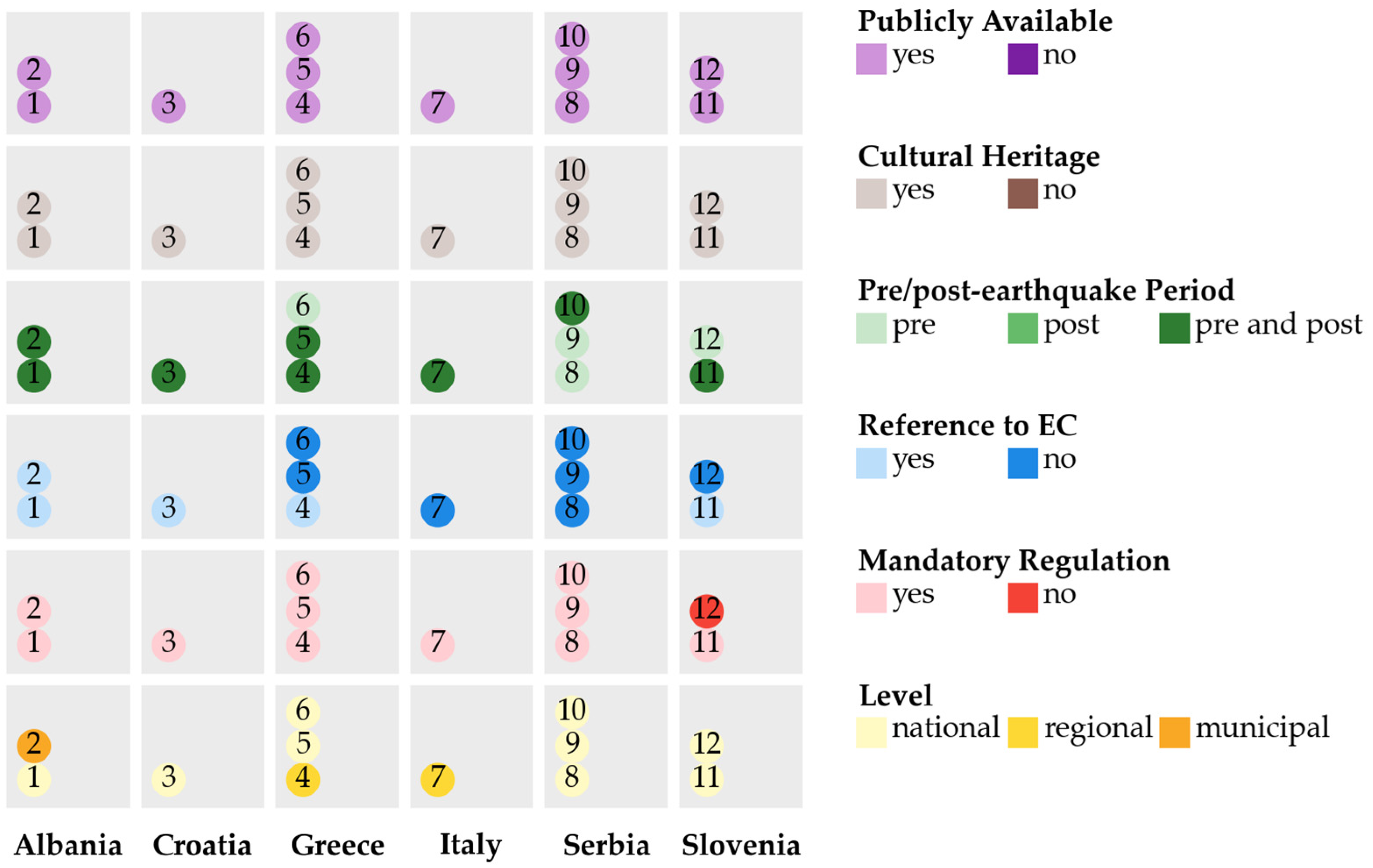

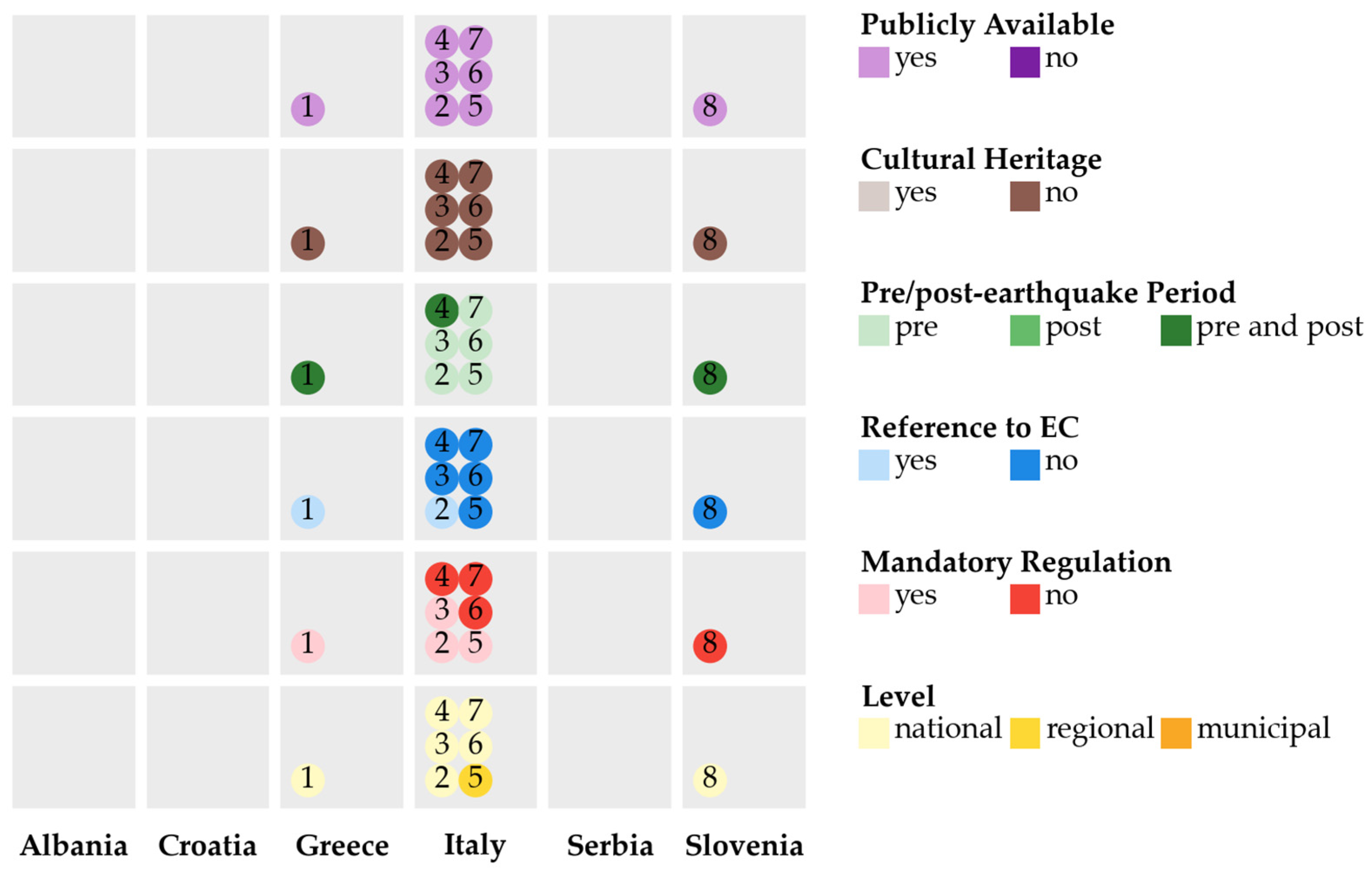
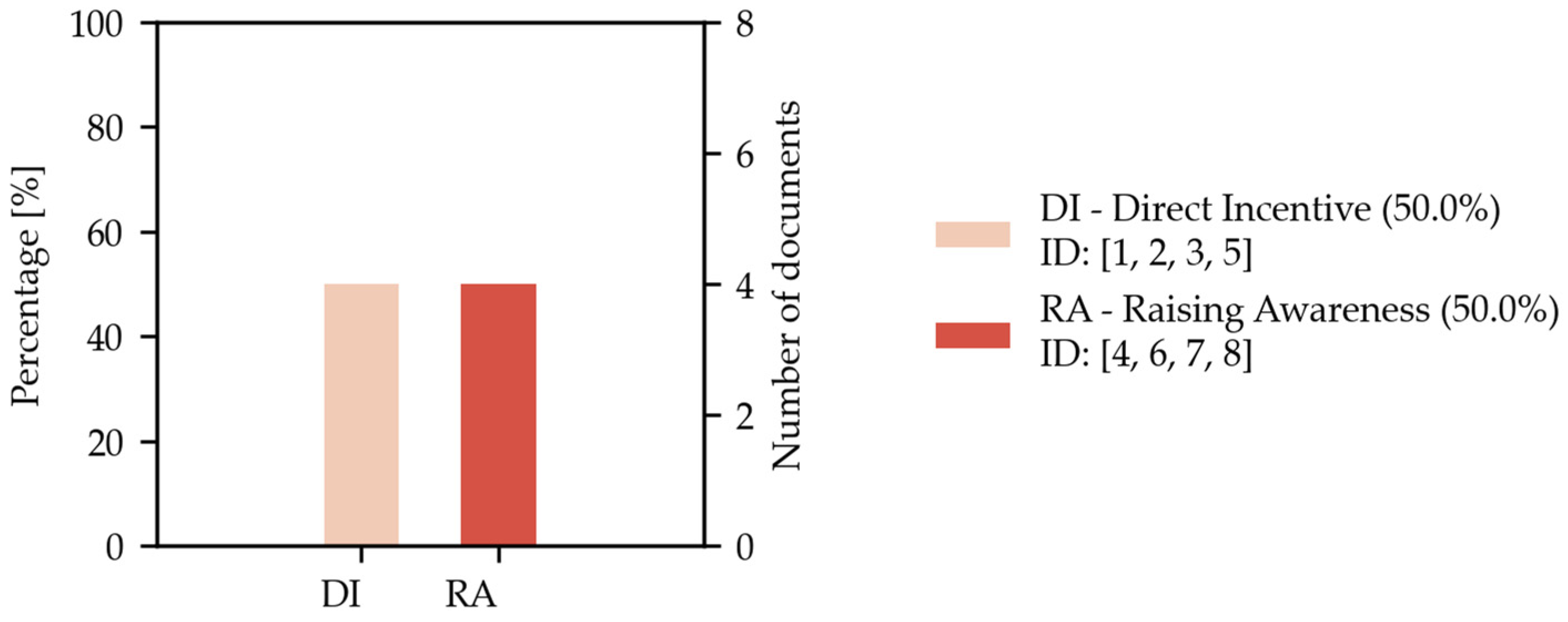
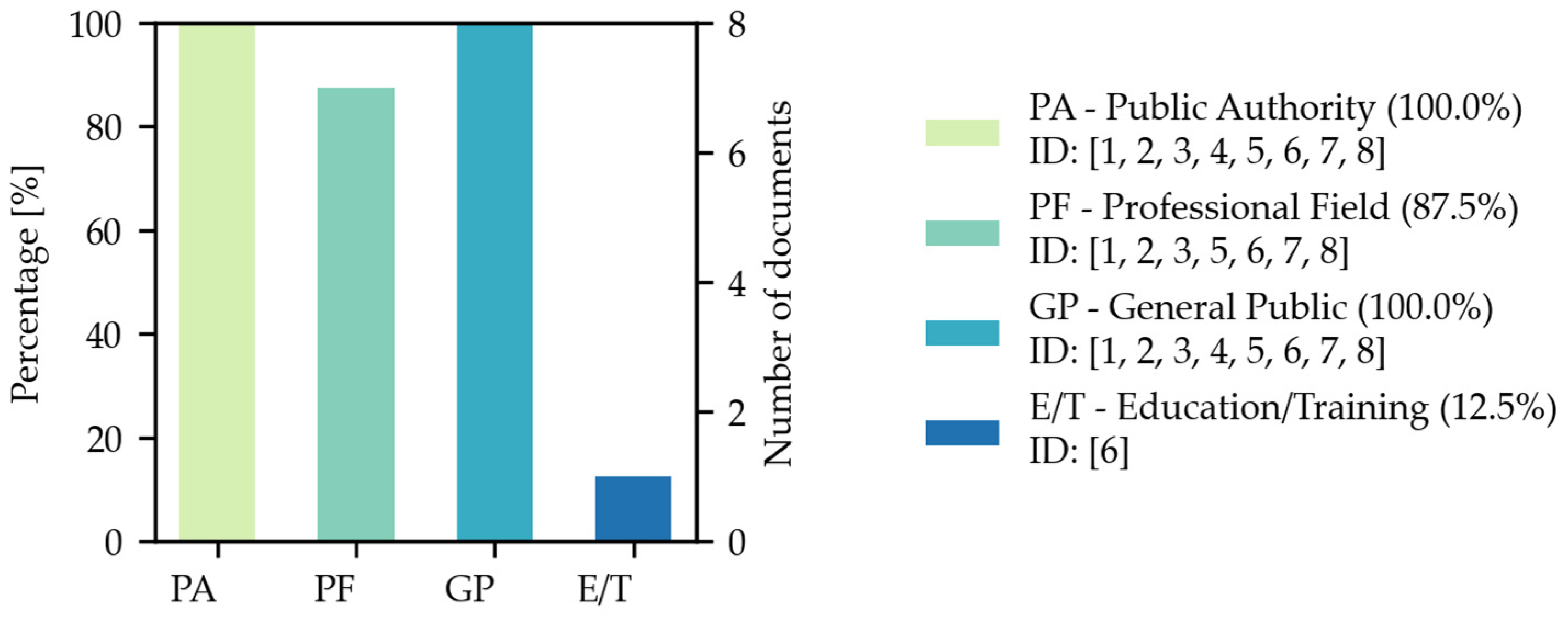
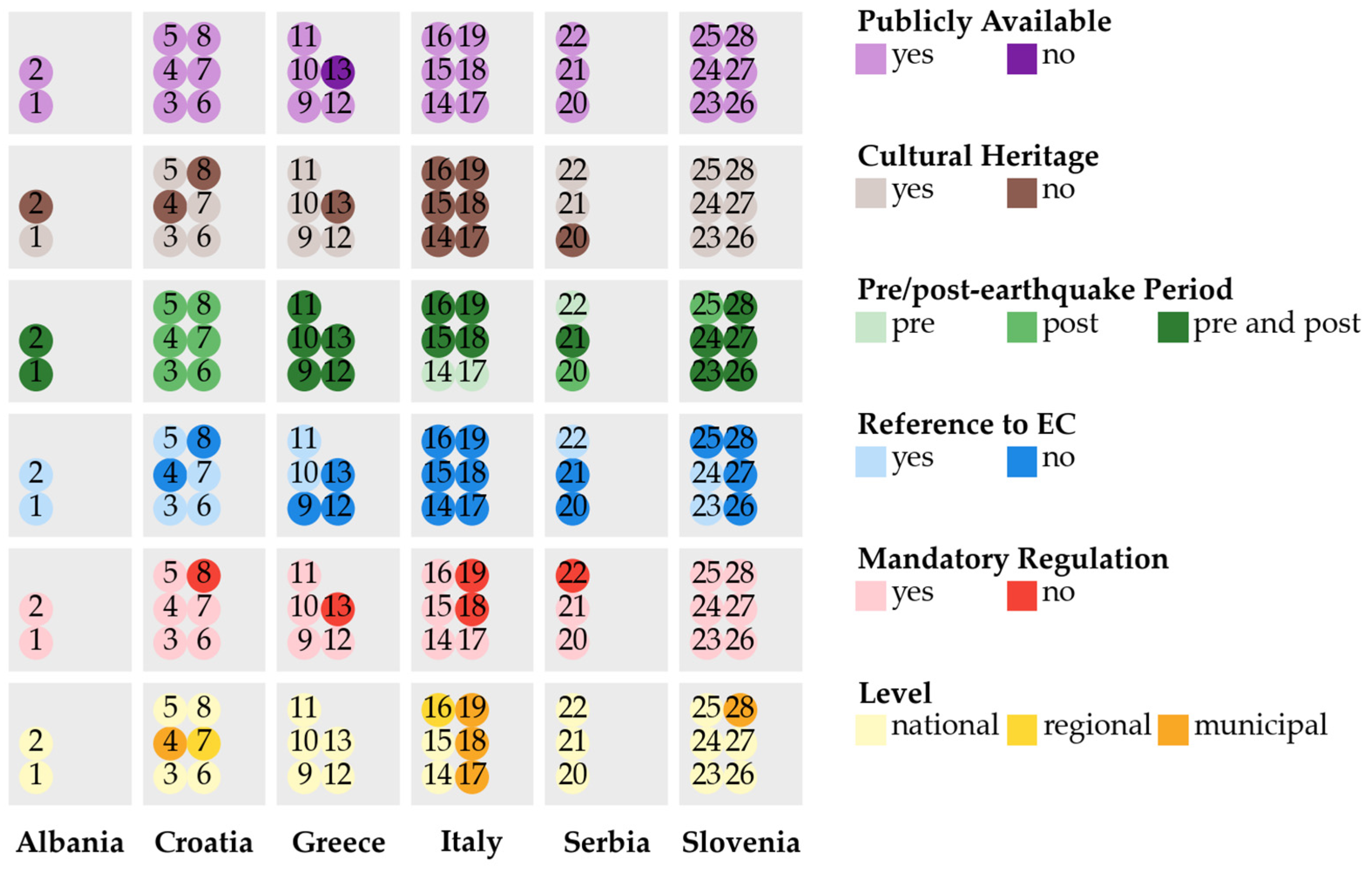
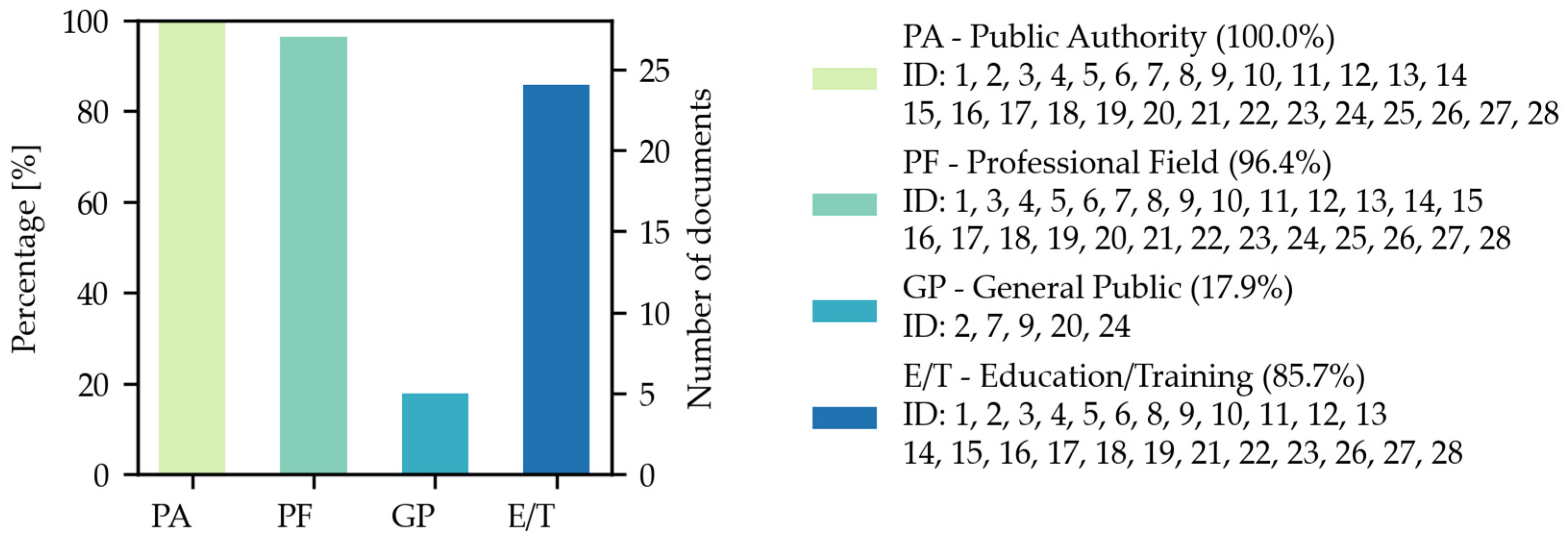
| Project Partner Country/Topic | Albania | Croatia | Greece | Italy | Serbia | Slovenia |
|---|---|---|---|---|---|---|
| Country area [km2] [13] | 28,748 | 56,594 | 131,957 | 301,340 | 77,474 | 20,273 |
| Population [/] [14] | 2,793,592 | 3,862,305 | 10,459,782 | 59,030,133 | 6,797,105 | 2,107,180 |
| GDP per capita [eur] 1 [15] | 6500 | 17,260 | 19,650 | 33,860 | 9530 | 26,980 |
| Maximum expected peak ground acceleration (PGA) [/] 2 | 0.36 g [16] | 0.38 g [17] | 0.56 g [18] | 0.30 g [19] | 0.25 g [20] | 0.325 g [21] |
| One of the strongest earthquakes in history 3,4 | Salento 1743 M = 7.1 Imax = X [22] | Dubrovnik 1667 M = 6.4 Imax = IX [23] | Heraklion 1856 M = 8.9 Imax = XI [24] | Messina 1908 M = 7.1 Imax = XI [25] | Lazarevac 1922 M = 6.0 Imax = VIII [26] | Idrija 1511 M = 6.8 Imax = X [27] |
| Most recent major earthquake in the country 3,4 | Mamurras 2019 M = 6.4 Imax = VIII [22] | Petrinja 2020 M = 6.4 Imax = IX [23] | Samos 2020 M = 7.0 Imax = IX [24] | Umbria 2016 M = 6.6 Imax = XI [25] | Kraljevo 2010 M = 5.5 Imax = VIII [26] | Bovec 1998 M = 5.7 Imax = VIII [27] |
| Document ID | Document Name | Year of Issuance | Country |
|---|---|---|---|
| SN_1 | Eurocode 8 [29] | 2004 | All 1 |
| SN_2 | KTP-N2-89 [30] | 1989 | Albania |
| SN_3 | Manual for Seismic Retrofitting of the Existing Masonry Buildings [31] | 2020 | Croatia |
| SN_4 | Techniques for the Repair and Strengthening of the Masonry Buildings [32] | 2020 | Croatia |
| SN_5 | EAK 2000—Greek seismic code [33] | 2000 | Greece |
| SN_6 | KAN.EPE—Code of interventions [34] | 2017 | Greece |
| SN_7 | Guidelines for Assessment and Structural Interventions on Masonry Buildings [35] | 2021 | Greece |
| SN_8 | NTC 2018—Technical frameworks for construction [36] | 2018 | Italy |
| SN_9 | Explanatory Circular for NTC 2018 [37] | 2019 | Italy |
| SN_10 | DPCM 9/02/2011—Evaluation and reduction of seismic risk of cultural heritage [38] | 2011 | Italy |
| SN_11 | Regional Law No. 19/2008 [39] | 2008 | Italy |
| SN_12 | D.G.R. n. 2272/2016 [40] | 2016 | Italy |
| SN_13 | Regional Law No. 16/2012 [41] | 2012 | Italy |
| SN_14 | Legislative Decree No. 189/2016 [42] | 2016 | Italy |
| SN_15 | OPCM n. 3519/2006 [43] | 2006 | Italy |
| SN_16 | DGR n. 1164/2018 [44] | 2018 | Italy |
| Document ID | Document Name | Year of Issuance | Country |
|---|---|---|---|
| BR_1 | Decision No. 159 on Design Standards for Kindergartens [45] | 2017 | Albania |
| BR_2 | Decision No. 319 on Design Standards for Schools [46] | 2017 | Albania |
| BR_3 | Construction Act of the Republic of Croatia [47] | 2013 | Croatia |
| BR_4 | Ν. 4067/2012—New Building Regulation [48] | 2012 | Greece |
| BR_5 | Decision No. 3328—Reinforced Concrete Regulation [49] | 2016 | Greece |
| BR_6 | YA D1492330/2008—Steel Regulation [50] | 2008 | Greece |
| BR_7 | Building Regulations of the Municipality of Bologna [51] | 2020 | Italy |
| BR_8 | D.P.R. n. 380/2001 and subsequent modifications and additions [52] | 2001 | Italy |
| BR_9 | Planning and Building Act of the Republic of Serbia [53] | 2009 | Serbia |
| BR_10 | Regulation on Building Structures [54] | 2019 | Serbia |
| BR_11 | Building Act of the Republic of Slovenia [55] | 2021 | Slovenia |
| Document ID | Document Name | Year of Issuance | Country |
|---|---|---|---|
| UPR_1 | Law No. 107/2014 on Territorial Planning and Development [56] | 2014 | Albania |
| UPR_2 | General Local Plan of the Gjirokastër Municipality [57] | 2015 | Albania |
| UPR_3 | The law on spatial planning Act No. 153/2013 [58] | 2013 | Croatia |
| UPR_4 | Decision No. 42284/13.10.2017—Revised Regional Spatial Framework [59] | 2017 | Greece |
| UPR_5 | General Urban Plans (Law No. 2508/1997) [60] | 1997 | Greece |
| UPR_6 | Geological Suitability Studies—Ministries’ Decision 37691/2007 [61] | 2007 | Greece |
| UPR_7 | Regional Law No. 24/2017 [62] | 2017 | Italy |
| UPR_8 | Planning and Building Act of the Republic of Serbia [53] | 2009 | Serbia |
| UPR_9 | Rules on the Content, Method, and Procedure for Preparing Spatial and Urban Planning Documents [63] | 2019 | Serbia |
| UPR_10 | Strategy for Sustainable Urban Development of the Republic of Serbia until 2030 [64] | 2019 | Serbia |
| UPR_11 | Spatial Planning Act (ZUreP-3), No. 199/21 [65] | 2021 | Slovenia |
| UPR_12 | Regulatory Elements of Spatial Planning Handbook [66] | 2020 | Slovenia |
| Document ID | Document Name | Year of Issuance | Country |
|---|---|---|---|
| SIF_1 | FEK 2943/B-2023—Seismic Inspection of Public Buildings Framework for Pre-Earthquake Monitoring of Public Utility Buildings [67] | 2001 | Greece |
| SIF_2 | Sismabonus—Law No. 77/2020 [68] | 2020 | Italy |
| SIF_3 | D.M. No. 58/2017—Guidelines for the Evaluation of Seismic Vulnerability of Buildings [69] | 2017 | Italy |
| SIF_4 | “I Don’t Take Risks”—National Awareness Campaign for Risk Prevention and Preparedness [70] | 2010 | Italy |
| SIF_5 | Volumetric Incentives for Seismic Retrofitting Interventions [71] | 2017 | Italy |
| SIF_6 | “EDURISK”—Increasing Knowledge and Awareness of Seismic Risk in Schools [72] | 2011 | Italy |
| SIF_7 | “Secure +”—Online Tool to Raise Awareness on Seismic Risk of Italian Municipalities [73] | 2020 | Italy |
| SIF_8 | POTROG Applications [74] | 2013 | Slovenia |
| Document ID | Document Name | Year of Issuance | Country |
|---|---|---|---|
| PEP_1 | Law No. 45/2019 on Civil Protection [75] | 2019 | Albania |
| PEP_2 | National Civil Emergency Plan of Albania [76] | 2004 | Albania |
| PEP_3 | Emergency Seismic Reconstruction Program [77] | 2020 | Croatia |
| PEP_4 | Plan for the Development of the Civil Protection System in the City of Kaštela [78] | 2016 | Croatia |
| PEP_5 | Plan for Protection and Rescue in the Republic of Croatia [79] | 2010 | Croatia |
| PEP_6 | Civil Protection System Act [80] | 2015 | Croatia |
| PEP_7 | Law on the Reconstruction of Buildings Damaged by the Earthquake in the City of Zagreb, Krapina-Zagorje County, and Zagreb County [81] | 2020 | Croatia |
| PEP_8 | The Manual for Emergency Seismic Reconstruction Program [82] | 2020 | Croatia |
| PEP_9 | Ministerial Decision No. 1299/2003—General Civil Protection Plan “Xenokrates” [83] | 2003 | Greece |
| PEP_10 | Law 4662/2020—National Crisis Management and Risk Mitigation Framework [84] | 2020 | Greece |
| PEP_11 | General Civil Protection Plan—“Engelados II” [85] | 2023 | Greece |
| PEP_12 | Law 3013/2002 on the Upgrade of Civil Protection [86] | 2002 | Greece |
| PEP_13 | Guidelines for Planning and Execution of Civil Protection Exercises [87] | 2020 | Greece |
| PEP_14 | National Plan for the Prevention of Seismic Risk, Law No. 77 [88] | 2014 | Italy |
| PEP_15 | National Seismic Risk Rescue Program DPCM 14/01/2014 [89] | 2014 | Italy |
| PEP_16 | National Seismic Risk Rescue Program—Annex II (Emilia–Romagna) [90] | 2019 | Italy |
| PEP_17 | Municipal Civil Protection Plan of Bologna [91] | 2016 | Italy |
| PEP_18 | Seismic Microzonation (MS) studies [92] | 2010 | Italy |
| PEP_19 | Analysis of the Emergency Limit Condition (CLE) [93] | 2012 | Italy |
| PEP_20 | Law on Recovery Following Natural and Other Disasters [94] | 2020 | Serbia |
| PEP_21 | Law on Disaster Risk Reduction and Emergency Management [95] | 2018 | Serbia |
| PEP_22 | Catastrophe Risk Assessment in the Republic of Serbia [96] | 2019 | Serbia |
| PEP_23 | Law on Protection Against Natural and Other Disasters [97] | 2006 | Slovenia |
| PEP_24 | Resolution on Strengthening Earthquake Resilience by 2050 “Beat the earthquake” (ReKPV50) [98] | 2023 | Slovenia |
| PEP_25 | Decree on the Methodology for Damage Assessment [99] | 2008 | Slovenia |
| PEP_26 | Decree on the Organization, Equipment, and Training of Protection and Aid Forces [100] | 2016 | Slovenia |
| PEP_27 | National Plan for Civil Protection and Disaster Relief in Case of Earthquake [101] | 2024 | Slovenia |
| PEP_28 | Municipal Earthquake Protection and Rescue Plan for the City of Ljubljana [102] | 2024 | Slovenia |
Disclaimer/Publisher’s Note: The statements, opinions and data contained in all publications are solely those of the individual author(s) and contributor(s) and not of MDPI and/or the editor(s). MDPI and/or the editor(s) disclaim responsibility for any injury to people or property resulting from any ideas, methods, instructions or products referred to in the content. |
© 2025 by the authors. Licensee MDPI, Basel, Switzerland. This article is an open access article distributed under the terms and conditions of the Creative Commons Attribution (CC BY) license (https://creativecommons.org/licenses/by/4.0/).
Share and Cite
Triller, P.; Santangelo, A.; Marzani, G.; Kreslin, M. Towards Harmonized Reduction of Seismic Vulnerability: Analyzing Regulatory and Incentive Frameworks in the Adriatic—Ionian Region. Urban Sci. 2025, 9, 319. https://doi.org/10.3390/urbansci9080319
Triller P, Santangelo A, Marzani G, Kreslin M. Towards Harmonized Reduction of Seismic Vulnerability: Analyzing Regulatory and Incentive Frameworks in the Adriatic—Ionian Region. Urban Science. 2025; 9(8):319. https://doi.org/10.3390/urbansci9080319
Chicago/Turabian StyleTriller, Petra, Angela Santangelo, Giulia Marzani, and Maja Kreslin. 2025. "Towards Harmonized Reduction of Seismic Vulnerability: Analyzing Regulatory and Incentive Frameworks in the Adriatic—Ionian Region" Urban Science 9, no. 8: 319. https://doi.org/10.3390/urbansci9080319
APA StyleTriller, P., Santangelo, A., Marzani, G., & Kreslin, M. (2025). Towards Harmonized Reduction of Seismic Vulnerability: Analyzing Regulatory and Incentive Frameworks in the Adriatic—Ionian Region. Urban Science, 9(8), 319. https://doi.org/10.3390/urbansci9080319





